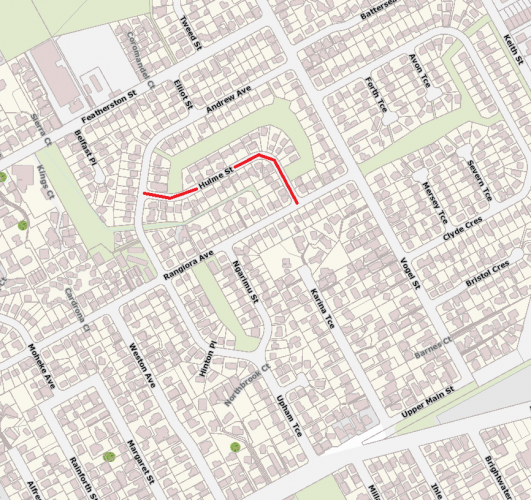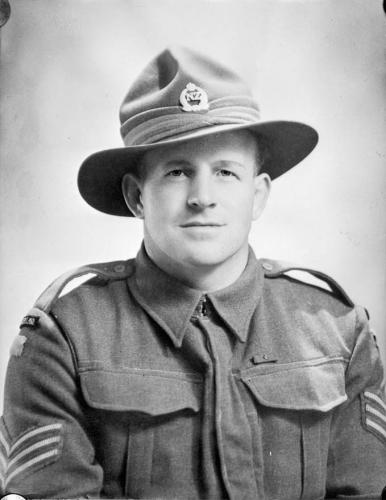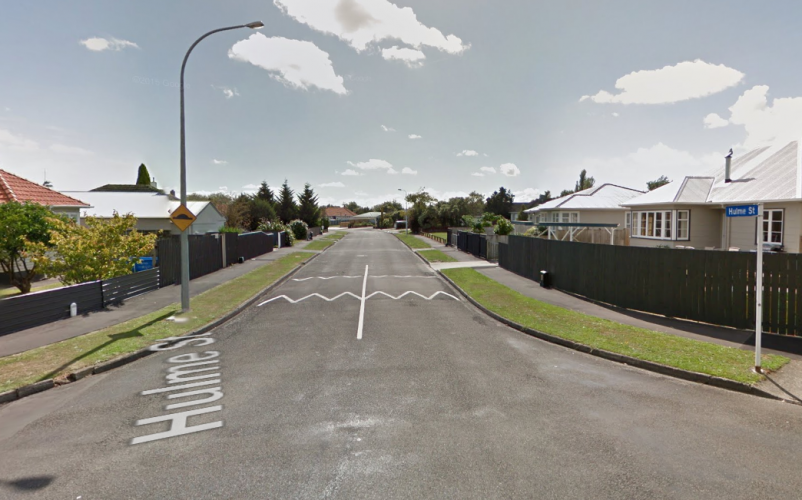116 Hulme St Palmerston North, street scene 2017
Reason for the name
This Palmerston North street was named in honour of Sergeant Alfred Clive Hulme VC
The suburb now known as Roslyn was originally part of the suburb of Terrace End. One of the early residents of Terrace End was Mr Charles Ross, a draper, who built a large house in the area. After his death in 1924, his widow sold 20 acres of land to the Government, who promptly named the area Roslyn in honour of him. Following the initial state house development of Rangiora Avenue on this land, further sections to the east of the area were sought for redevelopment. This included sections 173 to 179, owned by J D Buchanan, another prominent Palmerston North local, and this land was purchased by the Department of Housing in November 1944.
A motion at a Council Meeting on 19 August 1946 created a sub-committee for street naming made up of the Mayor, as well as Councillors Hart and Tremaine. On 17 March 1947 this committee recommended that those roads making up the old Buchanan and Main Street blocks were to be named after suggested Victoria Cross recipients. Although the Palmerston North Branch of the Returned Services Association suggested “VC” be added to each street, this was not adopted.
Hulme Street is a dog-leg street with one entrance at its southern end along Rangiora Avenue, sweeping west and finally terminating at Andrew Avenue. The street is approximately 400 metres long and has 45 residential properties along its length. Hulme Street Reserve has 2 entrances from Hulme Street and wraps around the eastern side of the street. Roslyn Kindergarten, Rangiora Reserve, Norton Park and Clyde Crescent Reserve are in close proximity to Hulme Street.
Author: Evan Greensides, Heritage Assistant for Palmerston North City Libraries & Community Services.
About Sergeant Alfred Clive Hulme
Alfred Clive Hulme was born in Dunedin on 24 January 1911 to Florence Sarah Matthews and her husband, Harold Clive Hulme, a clerk, and was brother to 3 siblings. Clive, as he was known, was educated at Eastern Hutt School and was a keen amateur wrestler. After leaving school he worked as a farm labourer throughout the South Island, and on 3 May 1934 he married Rona Marjorie Murcott in Nelson.
Clive enlisted on 22 January 1940, just two days shy of his thirtieth birthday, and during training reached the rank of corporal. During this time he was noted as having “an astonishing gift for initiative and leadership, a cool head and remarkable skill at arms.” He embarked for Egypt with the 23rd Battalion as part of the 2nd Echelon of the Second New Zealand Expeditionary Force, and was promoted to sergeant. After being diverted to Britain for the remainder of 1940 when German troops appeared to be preparing to invade, the 23rd Battalion later joined the 2nd New Zealand Division in March 1941, shortly before the New Zealanders’ first engagements in Greece and Crete. It was here that Clive’s previously noted leadership skills led to his command of a field punishment centre for the Battalion at Platanias, Crete.
Upon sighting the first wave of German paratroopers descending upon the island, Clive gathered the men of the punishment detachment, dispersed nearby rifles and led the group to the front lines. The first actions of the battle occurred at Platanias where he commanded a group of soldiers, destroying a number of German forward positions. Lieutenant W J G Roach noted that Hulme also acted alone during this time, “wander[ing] about a lot – from the camp to the road was all his country… Numerous snipers in this area were dealt with personally by Sergeant Hulme.”. During this time, Clive also managed to free a party of New Zealand engineers taken prisoner after sneaking up behind the lone sentry guarding the group and despatching him.
After the unsuccessful counterattack on the Maleme Aerodrome, Clive was involved in the delaying attack on Galatas. During the attack the 23rd Battalion was delayed by a machine-gun position. Seeing the situation, Clive went ahead alone and attacked the position with grenades, putting the German crew to flight and allowing the advance to continue. The next day, 26 May, he learnt that his brother, H C Hulme, also serving on Crete with the 19th Battalion, had died. The news deeply affected Clive, whereupon he “felt a cold need to avenge his brother’s death”. This began almost immediately; during the withdrawal from Galatas he camouflaged himself near a food dump, shooting three Germans and putting the rest to flight.
It was during these actions that Clive also undertook subterfuge, dressing himself in Fallschirmjager apparel and weaponry to make his way behind German lines to undertake a private war with German snipers. While the 23rd Battalion flanks were being harassed around 42nd Street near Suda, Clive volunteered to climb the surrounding hills to deal with 5 snipers. Working his way behind the group, Clive shot the leader and feigned knowledge of where the shot had come from when the others turned around. Dispatching another two in quick succession, he stalked the last two retreating snipers before killing them as well. This type of action would continue throughout the campaign, leading to Clive accounting for 33 enemy killed.
After the order to evacuate Crete had been given, the 23rd Battalion again withdrew, this time to Stylos. After two officers spotted German forces advancing up the hill towards the battalion, Sergeant Hulme took the lead, with the battalion’s official history books later stating,
Hulme was to be seen sitting side-saddle on the stone wall, shooting at the enemy on the lower slopes. His example did much to maintain the moral of men whose resources of nervous and physical energy were nearly exhausted
Although wounded in the arm from this action, Clive led an attack on a mortar position the very next day, putting it out of action. Shooting 3 more snipers, Clive was stalking a fourth before he was again shot, this time in the shoulder. Remaining with his unit in the Stylos area, he directed traffic until the 23rd Battalion withdrew to Sphakia, being evacuated from Crete on 30 May.
Clive’s actions on Crete led to his battalion commander, Lieutenant Colonel D F Leckie, recommending the award of the Victoria Cross. Brigadier Hargest’s statement recorded,
Sgt Hulme, during the whole fighting up till the moment of being wounded, conducted himself with such courage that the story of his exploits were on everybody’s lips. From my own personal observation I know he showed such a complete contempt for danger that it amounted to recklessness… The effect his actions had on all the men in his unit is incalculable, and he at once became almost legendary. I sincerely hope that the recommendation will be accepted.
The award of the Victoria Cross to Alfred Clive Hulme was gazetted on 10 October 1941. Despite being returned to New Zealand and discharged from the army after his wounds made him unfit for military service, he continued to serve with the home defence establishment until September 1943.
Clive later purchased a carrying business in Te Puke and continued in the trade until his retirement. As with Captain Charles Upham, Clive shied away from the fame which holding the Victoria Cross brought, only wearing the award during ANZAC Day ceremonies. Alfred Clive Hulme passed away on 2 September 1982 in Te Puke at the age of 71. His medals are currently on loan from the Hulme family to the National Army Museum in Waiouru.
Honours and Awards
- Victoria Cross
- 1939-1945 Star
- Africa Star
- Defence Medal
- War Medal1939-1945
- New Zealand War Service Medal
- Coronation Medal 1953
- Silver Jubilee Medal 1977
- Greek Commemorative War Medal 1940-1941
Citation for the award of the Victoria Cross, London Gazette, 10 October 1941:
Sergeant Hulme exhibited most outstanding and inspiring qualities of leadership, initiative; skill, endurance and most conspicuous gallantry and devotion to duty from the commencement of the heavy fighting in Crete, on 20th May, 1941, until he was wounded in action 28th May, 1941. On ground overlooking Maleme Aerodrome on 20th and 21st May he personally led parties of his men from the area held by the forward position and destroyed enemy organised parties who had established themselves out in front of our position, from which they brought heavy rifle, machine-gun and mortar fire to bear on our defensive posts. Numerous snipers in this area were dealt with by Sergeant Hulme personally; 130 dead were counted here. On 22nd, 23rd and 24th May Sergeant Hulme was continually going out alone or with one or two men and destroying enemy snipers. On 25th May, when Sergeant Hulme had rejoined his Battalion, this unit counter-attacked Galatos village. The attack was partially held up by a large party of the enemy holding the school, from which they were inflicting heavy casualties on our troops. Sergeant Hulme went forward alone, threw grenades into the school and so disorganised the defence that the counterattack was able to proceed successfully.
On Tuesday, 27th May, when our troops were holding a defensive line at Suda Bay during the final retirement, five enemy snipers had worked into position on the hillside overlooking the flank of the Battalion line. Sergeant Hulme volunteered to deal with the situation, and stalked and killed the snipers in turn. He continued similar work successfully through the day.
On 28th May at Stylos, when an enemy heavy mortar was severely bombing a very important ridge held by the Battalion rearguard troops, inflicting severe casualties, Sergeant Hulme, on his own initiative, penetrated the enemy lines, killed the mortar crew of four, put the mortar out of action and thus very materially assisted the withdrawal of the main body through Stylos. From the enemy mortar position he then worked to the left flank and killed three snipers who were causing concern to the rearguard. This made his score of enemy snipers thirty-three stalked and shot. Shortly afterwards Sergeant Hulme was severely wounded in the shoulder whilst stalking another sniper. When ordered to the rear, in spite of his wound, he directed traffic under fire and organised stragglers of various units into section groups.







